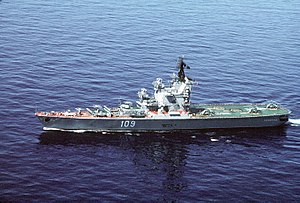This article includes a list of general references, but it lacks sufficient corresponding inline citations. (January 2013) |
 Leningrad underway in 1990.
| |
| Class overview | |
|---|---|
| Name | Moskva class |
| Operators | |
| Succeeded by | |
| Subclasses | Project 11780 |
| Built | 1962–1969 |
| In service | 1967–1996 |
| Planned | 3-12[1] |
| Completed | 2 |
| Cancelled | 1 |
| Retired | 2 |
| General characteristics [2] | |
| Type | Helicopter cruiser |
| Displacement |
|
| Length | 189 m (620 ft) |
| Beam | 34 m (112 ft) |
| Draught | 7.7 m (25 ft) |
| Propulsion | 2 × 45000 hp TV-12 steam turbines, 2 × fixed pitch propellers, 2 × 1500 kW TD-1500 turbine-type generators, 2 × 1500 kW diesel-generators |
| Speed | 28.5 knots (53 km/h) |
| Range | 9,000 nautical miles (16,668 km) at 15 knots (28 km/h) |
| Endurance | 15 days |
| Complement | 850 |
| Sensors and processing systems |
|
| Armament |
|
| Aircraft carried | 18 × Kamov Ka-25 'Hormone' or Mi-8 helicopters |
| Aviation facilities | Hangar deck |
The Moskva class, Soviet designation Project 1123 Kondor (condor) and S-703 Project 1123M Kiev, was the first class of operational aircraft carriers (helicopter cruisers in the Soviet classification) built by the Soviet Union for the Soviet Navy.[3]
These ships were laid down at Nikolayev South (Shipyard No.444). The lead vessel was launched in 1965 and named Moskva (Russian: Москва, lit. 'Moscow'); she entered service two years later. Moskva was followed by Leningrad (Russian: Ленинград, lit. 'Leningrad', which was commissioned in late 1968; there were no further vessels built, reportedly due to the poor handling of the ships in rough seas. Both were conventionally powered.
The Moskvas were not true "aircraft carriers" in that they did not carry any fixed-wing aircraft; the air wing was composed entirely of helicopters. They were designed primarily as anti-submarine warfare (ASW) vessels, and her weapons and sensor suite was optimized against the nuclear submarine threat. Their strategic role was to defend the Soviet ballistic missile submarine bastions against incursions by Western attack submarines, forming the flagships of an ASW task force.[4]
- ^ "StackPath".
- ^ "Project 1123 Kondor". russianships.info. Retrieved 22 July 2020.
- ^ Jordan, John, 'Soviet Warships 1945 to Present', Revised & Expanded Edition, ISBN 1-85409-117-4, Published by Arms & Armour Press (London, UK), 1992
- ^ Suciu, Peter (2023-12-23). "Moskva-Class: Russia's Aircraft Carrier That Really Isn't An Aircraft Carrier". The National Interest. Archived from the original on 2024-08-19. Retrieved 2024-10-06.
As a result, the Moskva-class shouldn't be seen as an "aircraft carrier" in the traditional sense, as it wasn't designed to carry any fixed-wing aircraft. Instead its air wing was composed entirely of helicopters. The vessels were also designed primarily for anti-submarine warfare (ASW) role – to counter the NATO Polaris submarines – and to act as flagship for other ASW warships. As such the weapons and sensor suite was fully optimized against a nuclear submarine threat.
Moreover, instead of serving as part of the nation's force projection, the Soviet doctrine called for the warships to serve in a strategic role that included defending the Soviet ballistic missile submarine bastions against incursions by Western attack submarines.